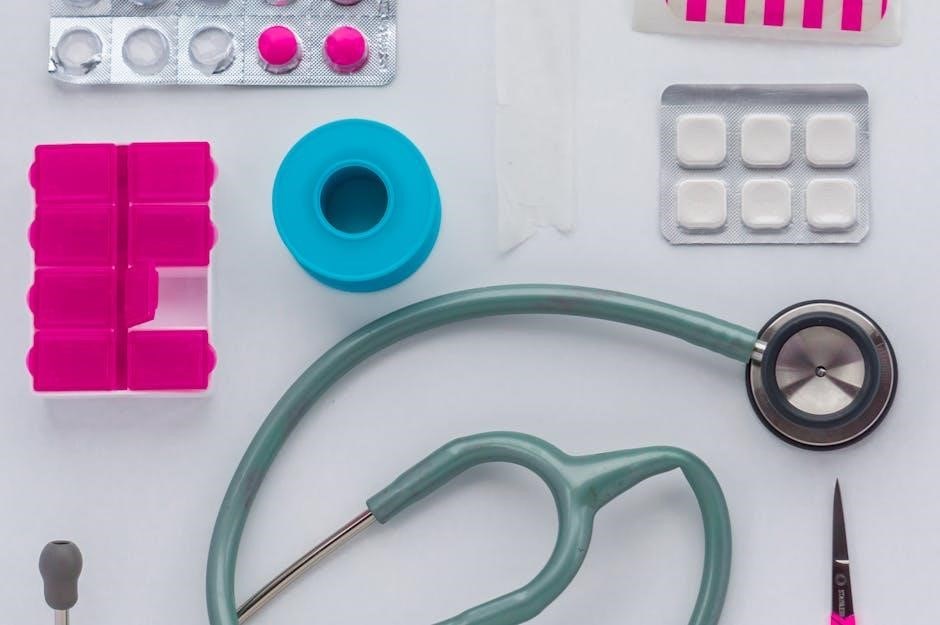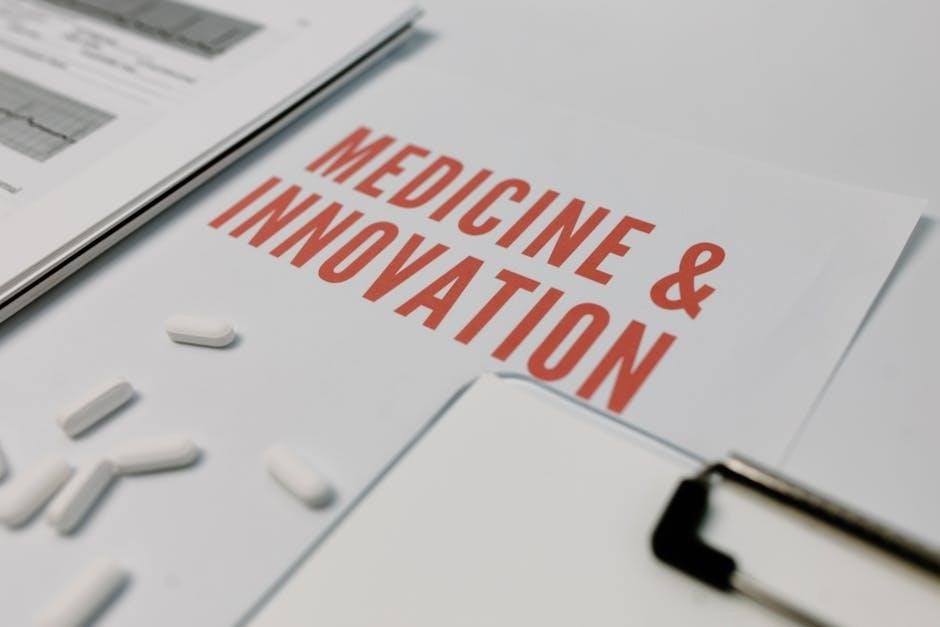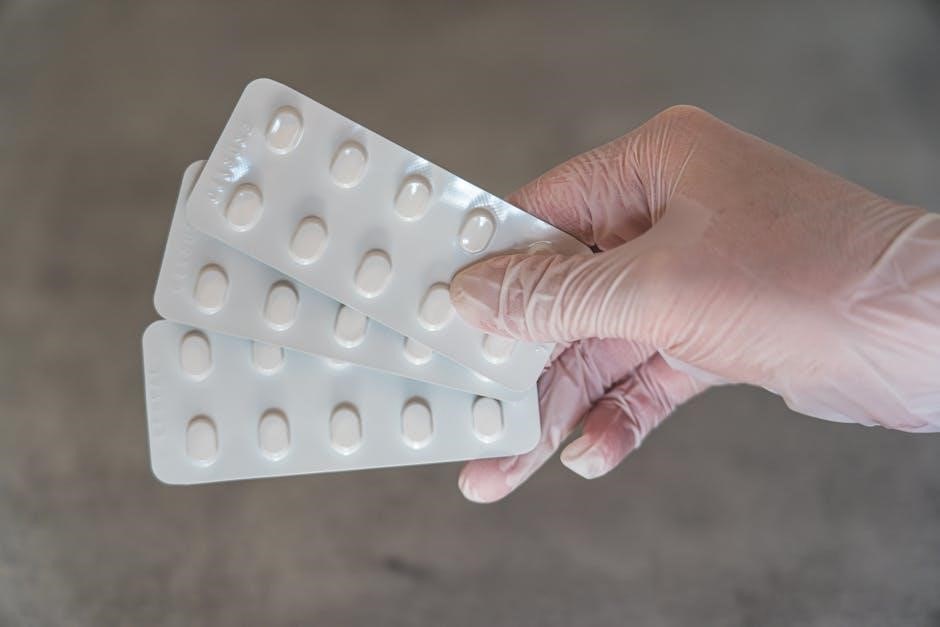nursing guide to drugs tiziani

Havard’s Nursing Guide to Drugs, authored by Adriana Tiziani, is a comprehensive resource for nurses, providing detailed drug information, nursing considerations, and dosage guidelines․ It is widely recognized for its user-friendly format and accessibility, making it an essential tool for safe and effective medication management in clinical practice․
1․1 Overview of the Guide
Havard’s Nursing Guide to Drugs is a trusted resource for nurses, offering detailed information on drug actions, uses, dosages, and nursing considerations․ It provides comprehensive coverage of medications, classified by therapeutic use and generic/trade names, ensuring easy access to critical drug data․ The guide is designed to support safe and effective medication management, making it an indispensable tool for nursing practice․
1․2 Importance of the Guide for Nursing Practice
Havard’s Nursing Guide to Drugs is a vital resource for nurses, ensuring accurate drug administration and patient safety․ It provides essential information on drug actions, dosages, and nursing considerations, enabling nurses to deliver high-quality care․ The guide supports clinical decision-making, helping nurses monitor patients effectively and educate them on medication use, making it indispensable for safe and effective nursing practice․

Key Features of the Guide
Havard’s Nursing Guide to Drugs offers comprehensive drug information, a user-friendly format, and accessibility․ It includes details on drug actions, dosages, and nursing considerations, ensuring safe and effective medication management․
2․1 Comprehensive Drug Information
Havard’s Nursing Guide to Drugs provides detailed information on each medication, including its action, therapeutic use, dosage, and nursing considerations․ It covers both generic and trade names, ensuring clarity and accessibility for nurses․ The guide emphasizes safety, highlighting potential interactions, side effects, and contraindications․ This comprehensive approach supports evidence-based practice, enabling nurses to deliver accurate and effective medication management․
2․2 User-Friendly Format and Accessibility
Havard’s Nursing Guide to Drugs features a user-friendly format, making it easy for nurses to access critical information quickly․ The guide is organized by therapeutic use and alphabetically, ensuring efficient navigation․ Its accessibility is enhanced by digital versions and the Tiziani Drug Calculations app, providing nurses with a comprehensive and integrated tool for reliable medication management in dynamic clinical settings․
Drug Classification in the Guide
Drug classification in the guide is organized by therapeutic use and generic or trade names, ensuring easy access to essential information for nurses․
3․1 Classification by Therapeutic Use
Drugs are classified by their therapeutic use, such as cardiovascular, antimicrobial, or anti-inflammatory agents․ This organization helps nurses quickly identify medications for specific conditions, enhancing clinical decision-making and patient care․
3․2 Classification by Generic and Trade Names
Drugs are categorized by both generic and trade names, ensuring easy identification and accessibility․ Generic names represent the chemical structure, while trade names are brand-specific․ This dual classification aids nurses in quickly locating medications, enhancing accuracy in administration and minimizing potential errors․ The guide includes both classifications, providing a comprehensive reference for clinical practice․

Pharmacological Foundations
Pharmacological foundations explain how drugs interact with the body, their effects, and underlying mechanisms․ This knowledge is crucial for understanding drug action, absorption, and therapeutic outcomes in nursing practice․
4․1 Mechanism of Drug Action
The mechanism of drug action involves interactions at cellular levels, such as binding to receptors, altering enzyme activity, or affecting ion channels․ Drugs can act as agonists, antagonists, or enzyme inhibitors․ Understanding these processes helps nurses predict therapeutic effects, potential side effects, and drug interactions, ensuring safe and effective administration in patient care․
4․2 Pharmacokinetics and Pharmacodynamics
Pharmacokinetics examines how drugs are absorbed, distributed, metabolized, and excreted in the body․ Pharmacodynamics studies the drug’s effects on biological systems․ Understanding these concepts is crucial for nurses to optimize drug administration, ensure therapeutic efficacy, and minimize adverse effects, promoting safe and effective patient care․

Drug Administration and Dosage
Drug administration and dosage are critical for therapeutic efficacy and patient safety․ The guide provides clear guidelines on drug routes, dosage calculations, and administration techniques to ensure accuracy and minimize errors․
5․1 Routes of Drug Administration
The guide details various drug administration routes, including oral, intravenous, intramuscular, subcutaneous, topical, and inhalational․ Each method is explained with considerations for patient condition, drug properties, and nursing best practices to ensure safe and effective delivery․ Clear guidelines help nurses choose the most appropriate route, optimizing therapeutic outcomes while minimizing complications․
5․2 Dosage Calculations and Safety
The guide emphasizes accurate dosage calculations, providing clear formulas and examples to minimize errors․ It highlights safety checks, such as verifying orders and monitoring for adverse effects․ Special attention is given to high-risk medications and vulnerable populations․ The Tiziani Drug Calculations App is recommended for precise calculations, ensuring safe and effective drug administration in clinical settings․

Nursing Considerations for Drug Therapy
Havard’s guide provides essential nursing considerations, including patient assessment, monitoring, and education․ It emphasizes individualized care, ensuring safe and effective drug therapy tailored to patient needs․
6․1 Assessment and Monitoring of Patients
Havard’s guide emphasizes thorough patient assessment and monitoring to ensure safe drug therapy; Nurses are advised to evaluate baseline health, monitor for adverse effects, and adjust treatments as needed․ The guide provides clear frameworks for documenting responses and identifying potential risks, particularly in vulnerable populations like pediatrics and geriatrics․ Regular monitoring ensures personalized care and optimal drug efficacy․
6․2 Patient Education and Compliance
Havard’s guide emphasizes patient education as a cornerstone of effective drug therapy․ Nurses are equipped with strategies to communicate clearly, ensuring patients understand their medications and potential side effects․ The guide provides tools like dosing schedules and patient-friendly materials to enhance compliance, fostering better health outcomes and empowering patients in their long-term care journey․
Common Drug Categories
Havard’s guide categorizes drugs by therapeutic use, covering cardiovascular, antimicrobial, and anti-inflammatory agents․ Each category includes detailed actions, uses, and nursing considerations, ensuring comprehensive understanding and application․
7․1 Cardiovascular Drugs
Cardiovascular drugs are essential for managing conditions like hypertension, heart failure, and arrhythmias․ They include antihypertensives, antiarrhythmics, and anticoagulants․ Nurses must monitor for side effects such as hypotension or bleeding, ensuring safe administration․ Patient education on lifestyle modifications and medication adherence is crucial for optimal outcomes․ The guide provides detailed nursing considerations and dosage guidelines, aiding nurses in delivering effective care․
7․2 Antimicrobial and Anti-Inflammatory Drugs
Antimicrobial drugs target infections, while anti-inflammatory drugs reduce inflammation․ Both are classified by their therapeutic use, with detailed nursing considerations․ Nurses must monitor for side effects like hypersensitivity reactions or gastrointestinal issues․ Patient education on proper use and adherence is vital․ The guide provides clear dosage guidelines and nursing cautions, ensuring safe and effective administration of these medications in clinical settings․
Special Populations and Drug Therapy
Havard’s Nursing Guide to Drugs addresses drug therapy for special populations, including pediatric, geriatric, pregnant, and breastfeeding patients, ensuring safe and effective medication management tailored to their unique needs․
8․1 Pediatric and Geriatric Considerations
The guide emphasizes tailored drug therapy for pediatric and geriatric populations, focusing on dosage adjustments and age-related physiological changes․ It highlights the importance of monitoring renal function, weight, and overall health in these groups to prevent adverse effects and ensure safe medication administration․
8․2 Drug Therapy During Pregnancy and Breastfeeding
The guide provides critical insights into drug therapy during pregnancy and breastfeeding, focusing on safety, fetal development, and lactation considerations․ It outlines medications that are safe or contraindicated, offering evidence-based guidelines to minimize risks to the fetus or infant while ensuring therapeutic benefits for the mother․

Drug Interactions and Side Effects
The guide provides critical information on potential drug interactions and adverse effects, offering practical advice for minimizing risks and managing reactions to ensure patient safety․
9․1 Identifying Potential Drug Interactions
Havard’s Guide details how to identify drug interactions by cross-referencing generic and trade names, ensuring nurses can anticipate and mitigate risks․ It highlights key nursing considerations and provides practical advice for minimizing adverse interactions, fostering safe medication administration․ The guide also emphasizes monitoring for signs of interactions, supported by evidence-based strategies to enhance patient outcomes and reduce complications․
9․2 Managing Adverse Drug Reactions
Havard’s Guide provides a comprehensive approach to managing adverse drug reactions, emphasizing prompt assessment and documentation․ Nurses are advised to monitor for signs of adverse reactions, implement tailored interventions, and educate patients on recognition and reporting․ The guide underscores the importance of evidence-based strategies to minimize harm and improve patient outcomes, ensuring safe and effective drug therapy management;

Legal and Ethical Considerations
Havard’s Guide emphasizes legal and ethical considerations, focusing on medication errors, liability, and patient rights, ensuring nurses understand their responsibilities in drug administration and documentation․
10․1 Medication Errors and Liability
Havard’s Nursing Guide to Drugs addresses medication errors, highlighting their impact on patient safety and legal implications․ It provides strategies to minimize errors, emphasizing accurate documentation and adherence to protocols․ Nurses are advised on liability risks, ensuring they understand their professional responsibilities and the importance of following best practices to avoid legal consequences․
10․2 Ethical Issues in Drug Administration
Havard’s Nursing Guide to Drugs emphasizes ethical considerations in drug administration, focusing on patient autonomy, informed consent, and non-maleficence․ It addresses dilemmas such as withholding medications, end-of-life care, and cultural sensitivities․ Nurses are guided to prioritize patient well-being, ensure privacy, and avoid harm, aligning their practice with ethical standards and professional responsibilities․

Digital Tools and Resources
Havard’s Nursing Guide to Drugs integrates with the Tiziani Drug Calculations app, offering digital solutions for safe drug administration and enhancing nursing practice efficiency․
11․1 The Tiziani Drug Calculations App
The Tiziani Drug Calculations app complements Havard’s Nursing Guide to Drugs, offering precise dosage calculations, enhanced safety, and seamless integration․ It supports nurses and students in clinical settings, ensuring accurate medication administration․ The app’s user-friendly design and robust functionality make it an indispensable tool for modern nursing practice, aligning with the guide’s mission to promote safe and effective drug therapy․
11․2 Integration of the Guide with Other Nursing Tools
Havard’s Nursing Guide to Drugs seamlessly integrates with other nursing tools, enhancing clinical efficiency․ The guide works alongside resources like the Tiziani Drug Calculations app, allowing shared functions and data․ This integration supports comprehensive medication management, ensuring nurses can access all necessary information in one place, improving patient care and streamlining workflows in dynamic healthcare environments․

Updates and Editions of the Guide
Havard’s Nursing Guide to Drugs has evolved through editions, with the 12th edition offering updated drug information and enhanced features ensuring accuracy for nursing practice․
12․1 Evolution of the Guide Over Editions
Havard’s Nursing Guide to Drugs has undergone significant updates across its editions, reflecting advancements in pharmacology and clinical practice․ From its early editions to the 12th edition, the guide has expanded its drug listings, enhanced nursing considerations, and incorporated new safety features․ Each edition builds on the previous one, ensuring nurses have access to the most current and reliable medication information to support safe and effective patient care․
12․2 Latest Updates in the 12th Edition
The 12th edition of Havard’s Nursing Guide to Drugs includes the latest drug entries, updated therapeutic classifications, and enhanced safety alerts․ It incorporates new evidence-based practices, expanded coverage of antimicrobial stewardship, and updated guidelines for geriatric care․ Digital integration has also been improved, with seamless access to the Tiziani Drug Calculations app, ensuring nurses have cutting-edge tools for accurate medication management and patient safety․

Author Insights and Expertise
Adriana Tiziani, a renowned nursing educator, brings extensive clinical and academic expertise to the guide, ensuring evidence-based, practice-focused content․ Her collaborative approach with specialists enhances the guide’s reliability and relevance․
13․1 Adriana Tiziani’s Contribution
Adriana Tiziani, a respected nursing educator and author, has significantly contributed to the guide’s development․ With a strong academic and clinical background, she ensures the content is evidence-based, relevant, and practice-focused; Her work spans multiple editions, incorporating updates and advancements in pharmacology․ Tiziani’s collaborative approach with experts enhances the guide’s credibility, making it a trusted resource for nurses worldwide․
13;2 Collaborators and Their Expertise
The guide benefits from contributions by experts like Mary Bushell, whose clinical and educational expertise enhances its practical relevance․ Collaborators, including pharmacologists and clinicians, ensure accurate and up-to-date content․ Their diverse backgrounds in nursing, medicine, and pharmacology provide a comprehensive perspective, making the guide a reliable resource for nursing professionals and students․ The team’s collective expertise ensures the guide remains a trusted reference for drug therapy and patient care․
Reviews and Feedback
Havard’s Nursing Guide to Drugs is highly regarded for its reliability and accessibility․ Nursing professionals and students praise its comprehensive content, user-friendly format, and practical relevance, making it an indispensable resource for medication management and education․
14․1 Nursing Professionals’ Perspectives
Nursing professionals highly value Havard’s Nursing Guide to Drugs for its reliability and accessibility․ Many praise its comprehensive content, including detailed drug information and practical nursing considerations․ The guide’s user-friendly format and up-to-date data make it an essential resource for safe medication administration․ Professionals appreciate its focus on both therapeutic uses and potential side effects, ensuring informed patient care and improved clinical outcomes․
14․2 Student Feedback and Recommendations
Students consistently praise Havard’s Nursing Guide to Drugs for its clarity and comprehensive coverage․ Many find it an invaluable resource for understanding complex drug information and calculations․ The guide’s organized format and practical tips are particularly highlighted․ Students recommend it for both academic study and clinical practice, emphasizing its role in building confidence in medication management and patient care․
Havard’s Nursing Guide to Drugs remains an indispensable resource for nurses, offering reliable drug information and practical insights․ Its continuous updates ensure relevance, fostering improved patient care and safety․
15․1 Summary of Key Points
Havard’s Nursing Guide to Drugs, authored by Adriana Tiziani, is a comprehensive resource offering detailed drug information, classifications, and nursing considerations․ It provides user-friendly access to essential medication details, including therapeutic uses, dosages, and safety precautions․ Regular updates ensure accuracy, while digital tools like the Tiziani Drug Calculations app enhance functionality․ The guide remains a vital tool for nurses, supporting safe and effective patient care․
15․2 Future Directions for the Guide
Future editions of Havard’s Nursing Guide to Drugs will focus on enhanced digital integration and accessibility․ Expanding the Tiziani Drug Calculations app with AI-driven features and more interactive content is planned․ Additionally, the guide will incorporate emerging trends in pharmacology, such as precision medicine and biotechnological advancements, ensuring it remains a cutting-edge resource for nursing professionals worldwide․


Leave a Reply
You must be logged in to post a comment.